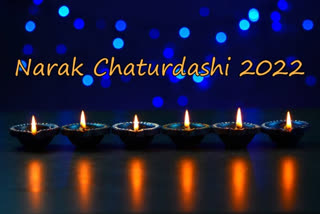Hyderabad: During the five-day-long Diwali festival, the second day is popularly known as Narak Chaturdashi or "Chhoti Diwali". Narak Chaturdashi is celebrated a day after Dhanteras. According to the Hindu calendar, the Chaturdashi Tithi during the Krishna Paksha of the month of Kartik will begin on October 23 at 6:40 PM and end on October 24 at 5:28 PM. According to Udaya Tithi, Narak Chaturdashi will be celebrated on October 24.
This festival is celebrated to commemorate Lord Krishna's victory over the demon king Narakasura. It is also believed that on this day Lord Hanuman reached Ayodhya with the news of Lord Ram's return after 14 years of exile. This festival is celebrated in different parts of India using different rituals. People in the southern parts wake up very early in the morning to make a kind of paste with vermilion and oil. They call it "Ubton" and apply it on their foreheads and take bath.
Also read:Dhanteras 2022: Purchasing gold and instructions to keep in mind while buying gold
According to mythology, after defeating Lord Indra and snatching Goddess Aditi's earrings, the demon king Narakasur became the ruler of Pragjyotishpur. Narakasura also kidnapped 16000 daughters of gods and sages and imprisoned them. On the eve of Naraka Chaturdashi, Lord Krishna killed Narakasura, freed the 16000 hostages from captivity and also reclaimed the precious earrings of Goddess Aditi. Thus, Naraka Chaturdashi is celebrated as a symbol of victory of good over evil.
At dusk, seven lamps are offered to the ancestors for the peace of their souls and also to illuminate the path of travel. This ritual is called 'Yama Pradeep'. It is customary to light a big lamp made out of flour called 'Yama' on this day. Walk around the house while holding the lamp once and place it outside the house. Take a bath before sunrise and hold a fast according to proper rituals. Light the 'Yama' lamp in the evening. Puja on this day is considered very auspicious for the family. It is believed that by lighting this lamp it is possible to get rid of going to 'Yamaloka'.
